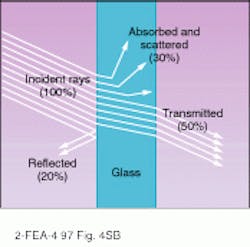When a beam of light strikes a thick sheet of glass in normal atmosphere, as much as 20% of the light may be reflected, another 30% may be absorbed and scattered, and the remainder transmitted. The sheet of glass is acting as a filter when it controls the transmission, absorption, and reflection of the light (see figure). Many filters are designed around these principles.
When light is incident on the interface between two media—air and glass, for example—the fraction of the energy that is reflected and the fraction that is transmitted depend on the refractive indices of the media. You can see yourself in someone else's eye glasses for example, because of the difference between the refractive index of air and that of the glass. Greater difference means higher reflectivity.
Most materials are quite selective in the way they absorb and reflect the different wavelengths of light. A magenta dye will transmit blue and red light but will absorb green. Gold and copper metals reflect red and yellow wavelengths more strongly than blue. A piece of green glass will absorb blue and red light and transmit green.
When light is transmitted, some of it may be scattered, and the scattered light will be refracted or polarized when it passes at angles not normal to the surface. It can also be polarized by reflection. Some filters use the polarization to control light flow. Light waves vibrate in an infinite number of directions perpendicular to their direction of travel. When certain directions of vibration are less impeded, allowing passage of those waves traveling in a single plane, the light is said to be polarized.
Polarizing filters operate on this principle, transmitting only those components of light with one polarization. The other components are absorbed. Polaroid sunglasses transmit only vertical vibration—eliminating the glare of light polarized by reflection from horizontal surfaces. Certain materials, such as quartz, can cause the polarization to be influenced as the light passes through the material.
Interference at work
Unlike solid objects, two or more lightwaves can occupy the same space at the same time, which naturally leads to interference. When lightwaves of equal wavelength occupy the same space, they interfere with each other in a manner determined by their difference in phase and amplitude. When two such lightwaves are exactly out of phase with each other (by 180°), they interfere destructively. If their amplitudes are equal, they will completely cancel each other, producing a wave of zero amplitude. If two such waves are exactly in phase, they interfere constructively, producing a lightwave of higher amplitude. Interference coatings at nonnormal incidence can be used as polarizing filters.
Manufacturers typically define filter performance in terms of transmission (T) and optical density (OD). Transmission is the portion of the total energy at a given wavelength impinging on a filter that passes through it. A transmission value is always a portion of unity, less than 1 and greater than 0: reflection + transmission + absorption = 1.
Transmission performance of a filter (usually when throughput is between 1% and 99%) is referred to as transmittance. For the attenuating performance of a filter (usually when throughput is less than 1%), the term to use is optical density. Attenuation is the suppression of a signal before it is detected in an optical system. Transmission can be expressed either as a percentage or as a decimal. Optical density is always expressed as the negative logarithm of transmission.
About the Author
Laurie Ann Peach
Assistant Editor, Technology
Laurie Ann Peach was Assistant Editor, Technology at Laser Focus World.
